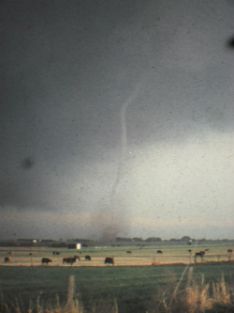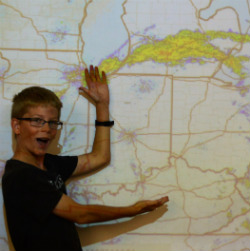The first thing you notice in Dave Carmichael’s weather and science class is that he often carries around a globe, using it as a prop to explain intertropical convergence, polar jet streams and pressure belts.
The second thing you notice is that Carmichael crams a lot of information into his 48-minute classes.
| Too Close for Comfort “The tornado veered off into the field only a few hundred yards behind us,” Carmichael recalled. “I was hanging out of the passenger’s side window of the car. The driver had our old, 1976 Plymouth Fury station wagon floored trying to outrun the tornado, which was traveling about 50 m.p.h. toward us.”  |
There’s weather, of course: “Anybody have an idea what causes wind?” he asks his third-hour seventh-graders. “Wind is air and motion. And if the pressure isn’t equal all around you, you’d explode in a big ball of goo.”
Some history and geography: “Because of the prevailing westerlies, Columbus had to find a different route if he was going to make it to Asia to trade spices … that’s why they call them ‘trade winds.'”
And a little bit of everything: “Anybody know what a cigar boat is? The 1990s? … They’d load those things up with drugs … but their compasses were really bad … got lost, and people would say ‘Oh no, aliens abducted them!’ You see? Weather influences our history.”
On this morning, 20-some pairs of eyes are glued to Carmichael’s globe-cradling, lab coat-wearing form as he darts back and forth across the front of the room.
“That’s what he’s known for: He talks super fast,” Max VanVliet tells a visitor. “I’ve never been in a class that’s talked about the things he talks about. This is definitely one of my hardest classes.”
Max’s neighbor, also named Max (Ungrey), chimes in: “When you hear somebody say they don’t like his class, it’s because they’re too lazy to do the extra credit.”
“Extra credit helps your grade a lot,” adds Aaron Wheeler from one row back.
Later, Carmichael will explain that Next Generation Science Standards, a way to build inquiry-based science skills, require his students to know how to read weather maps, “and that takes a ton of background and vocabulary words.” Getting it all in requires a little fast talking.

Scientific Sweet Spot
This year marks Carmichael’s 23rd as a science teacher, all of them at Grandville Public Schools. His students don’t find out until they get to the unit on tornadoes that he used to get paid — “about enough to buy food,” he says with a laugh — to chase them with a camera.
Or that he did a stint at the General Motors Research Labs developing computer models for atmospheric pollution studies. And was a television meteorologist for WOOD-TV8 from 1982 to 1994.
“When I was in broadcasting, it wasn’t a job you retired from,” he explains. “They wanted the young and beautiful, and I started to go grey very young. And my kids thought Daddy was the man in the little box. It got to the point where it just wasn’t the job if I wanted to be a family guy.”
He enrolled at Aquinas College and became certified to teach science and math. After a few years at Grandville High, he landed at the middle school and that’s where he has been since.
“I could never have taught elementary,” he said. “My wife did that for 29 years, and no. I loved getting into conversations with the high schoolers after class, about string theory and multi-universe theory … They’d eat it up.”
Middle school-age students seem to be the sweet spot, he said.
“They haven’t yet gotten to the point where they have more attitude over admiration. And they keep you active, that’s for sure.”
CONNECT









